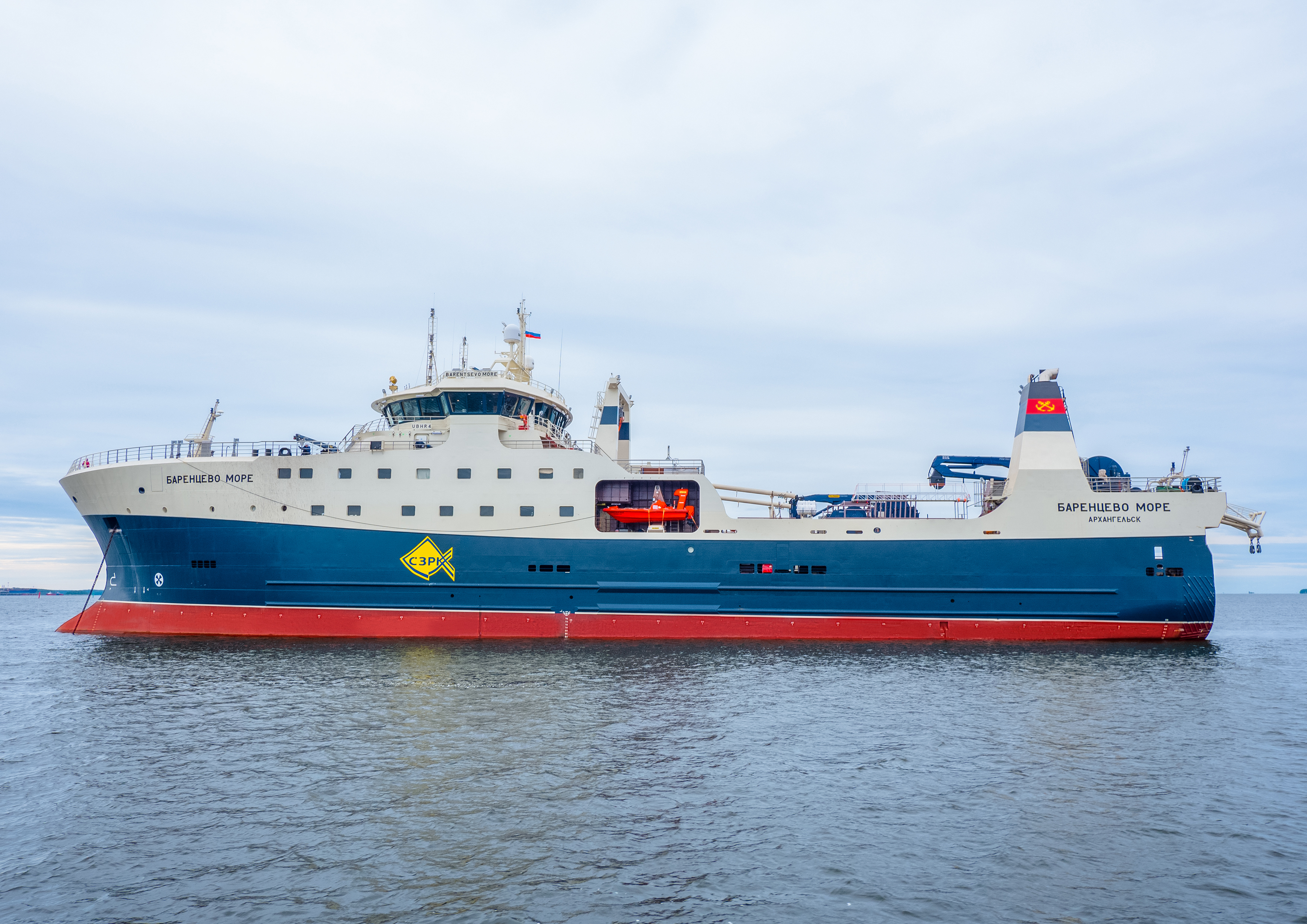The industry’s oldest fishery company – Arkhangelsk Trawl Fleet JSC (ATF) – has been fishing in the northern seas for over a hundred years. Today, ATF is one of the fishing industry leaders. In his interview with IAA PortNews, ATF General Director Sergey Zarubin tells about the problems with construction of new ships, ship repair, and development of the company’s stevedoring activities at its own berths.
- Could you please tell about the recovery of the company which was in desperate condition before 2014
- The history of Arkhangelsk Trawl Fleet began in 1920. Of course, over 100 years the company has seen ups and downs while keeping the main thing – expertise and skills in operation of the fishing fleet. Actually, when ATF joined North West Fishing Consortium (NWFC), big Russian non-profit partnership, in 2014, it was in a deplorable state. The recovery began with the expansion of the fishing fleet: technically sound ships purchased in the secondary market were put into operation. That let us succeed in taking the annual fish quotas in full.
Investments in business recovery exceeded RUB 1.5 billion over eight years
At the same time, we revised all the expenses of the company, optimized business processes, settled all the debts to other companies and states (taxes), organized sales of the products. The main thing – we raised payments to our employees to ensure their belief in our strength and optimism about the future with their heads held up. Simultaneously, we started repairing all production facilities of ATF: acquired new equipment for our ship repair segment, refurbished offices, conducted certification of all employees and organized free meals at work. Social decisions allowed us preserve the team of ATF, all its specialists.
- What was the volume of investments in business recovery?
- Over eight years, investments in business recovery exceeded RUB 1.5 billion. The bulk of the amount was allocated for the development of our stevedoring business. We purchased loaders and a new crane of 45 tonnes in capacity. The entire fleet of vehicles was renewed. That ensured good results: in 2021, over 140 thousand tonnes of cargo was handled at our berths. Apart from fish products we handle general cargo and containers.
As for the fleet modernization, our tugboat underwent capital repair with installation of new engines and navigation system.
ATF maintenance base offers comprehensive ship repair services. We have a hull-welding workshop, a machine shop and our own berths of almost 400 meters as well as a dock of up to 2,500 tonnes in capacity. Gradual modernization of machinery equipment is underway. We are switching to more advanced technologies, acquire new welding equipment and instruments. I emphasize that a big share of equipment is purchased in Russia, namely welding equipment, hydraulic units for ship repair, special equipment and tools.
- Are you continuing the retrofit programme in ship repair segment this year?
- Yes, the plan for modernization of our ship maintenance base is estimated at about RUB 100 million in 2022. Besides, we are looking eyeing the construction of new dock of up to 130 meters in length and up to 10 thousand tonnes in capacity.
- Do investments in ship repair pay back?
- Of course, as the demand for ship repair is always on the rise. As of today, the facilities of our maintenance base are 100% loaded until June 2023.
- What is the performance of ATF stevedoring division?
- At our berths we accept vessels of up to 160 meters in length, not only fishing ships. The draught at our cargo berths is 7.8 meters. The port’s total area is 98,000 square meters an all the storage yards are paved with concrete. To perform loading/unloading operations we use 4 rail-mounted portal cranes, 2 crawler-mounted cranes and one automobile crane for operation in the rear yards as well as 10 diesel and electric loaders.
The plan for the current year foresees 30-pct increase of throughput to 180 thousand tonnes
In 2021, we handled 56 ships including only 18 ships with fish, most of them were loaded with general cargo. Fish was delivered from the fishing areas by our trawlers, Ashinsk and Yagry, about 3.7 thousand tonnes. Besides, we accepted 3 thousand tonnes of frozen fish delivered by the Northern Sea Route from the Far East. Everything is reloaded to our own refrigerating storage facilities.
The plan for the current year foresees 30-pct increase of throughput to 180 thousand tonnes. Our own fishing volumes are to reach 4 thousand tonnes and we also expect 2 thousand tonnes of crab. Cargo volumes delivered by the Northern Sea Route from the Far East are to double to 6 thousand tonnes.
- What is the loading percentage of your stevedore facilities?
- We have great potential for the port development but seasonal fluctuations should be taken into consideration. In spring-summer season we use about 60-70% of our throughput capacity while in winter, when ships enter only with the assistance of icebreakers, the port’s throughput is considerably down. Cargo handling in winter can be at least doubled.
- Investments will result in the growth of both onshore and onboard personnel. How do you resolve personnel matters?
- We actually pay much attention to training of personnel for our industry in general, not only for our company.
ATF has its own training ship Belokamenka for a practical training of crewmembers working on fishing ships and commercial ships. Training is conducted by active masters and chief engineers for students coming from all around Russia. When it comes to training of personnel for the fishing industry, I would like to express appreciation of Elena Kudryashova, Rector of the Northern (Arctic) Federal University, for organization of training.
It should be noted that the ship repair industry features extreme personnel shortage. We are extremely short of many skilled workers. The industry needs state support through the revival of vocational schools and promotion of the occupational prestige and image.
- As for construction of new ships, you have taken the delivery of two new trawlers built under the investment quotas programme. Two more are under construction at Vyborg Shipyard. What are the prospects of their completion in the near time? Do you incur any expenses due to disruption of the construction schedule?
- Six years ago we made a decision on taking part in a state programme known as ‘keel quota’ and on 9 November 2016 we signed contracts with Vyborg Shipyard PJSC for construction of four large fishing/processing trawlers. We took the delivery of the first two ships, the Barents Sea and the Norwegian Sea, in 2020 and 2021, with the delay for 14 and 21 months accordingly. But those are excellent and they have proved themselves in the fishery.
The situation with the third and the forth ships is much worse. Initial delivery deadline has been postponed to the end of 2022, under the additional agreement with Vyborg Shipyard. However, according to our estimates, they cannot be built before the mid-2023. In general, the delay is up to 2.5 years. There is a risk for the second and the third ship to exceed the five-year period allowed under the investment quotas programme.
Extra costs of ATF due to the shipyard’s disruption of construction deadlines may total between RUB 438 million and RUB 1.24 billion
Meanwhile, ATF implements its obligations under the contract with Vyborg Shipyard in full. Therefore, all the delivery delays have a negative impact on our company’s financial and economic state. We have to pay interest on loans raised for construction of trawlers and incur expenses on technical management of shipbuilding contracts. Besides, we incur expenses on servicing bank guarantees handed over to Rosrybolovstvo (Russian Federal Fisheries Agency – Ed.) to secure implementation of the investment project. Finally, if the construction period of trawlers exceeds the five-year period we will incur expenses on covering those bank guarantees.
Thus, extra costs of ATF due to the shipyard’s disruption of construction deadlines will make at least RUB 438 million, or, in case of the negative scenario with the excess of the five-year period, they may total RUB 1.24 billion which does not include the loss of profit with no revenues from fishing.
- Rosrybolovstvo insists on passing the bill on the second phase of investment quotas in 2023 although it earlier considered it impossible before 2025. Is there a need of an urgent solution?

- The Chamber of Control and Accounts of the Russian Federation is currently assessing the results of the first phase of investment quotas distribution. The assessment will be completed by the end of the current year. That will be the first official document containing the analysis of the current reforms in the fishery industry. Obviously, all the next phases, if any, should take into consideration the results of the initial one.
In my opinion, there is no reason to hurry with the second phase of investment quotas
I would like to remind that the purpose of the investment quotas programme was the decrease of concentration, the increase of competition, the reduction of fish product prices, the fleet modernization. As for the first two targets, the result was just the opposite and the construction deadlines are postponed several times.
Yes, auctions have brought considerable financial resources to the federal budget but today we already see a considerable decrease in regional and local revenues. Besides, revenues from auctions will evidently sink several times in the current situation.
According to the Russian Union of Industrialists and Entrepreneurs (RUIE), the fishery industry reform planned for 2023 will cost entrepreneurs more than RUB 471 billion. In the current economic situation, this load on the business is inadmissible.
We agree with this opinion of RUIE and consider it reasonable to shift the second phase of investment quotas distribution for 2025. That is because of the delay in construction of ships under the second phase of the reform. On the average, that delay starts from 1.5 years. Shipyards lack shipbuilding sites and import components, there are difficulties with availability of foreign specialists. Besides, sanctions entail the necessity to replace main equipment on many ships under construction and revise the designs which also shifts the deadlines for 1.5-2 years. Dealing with additional orders at overloaded shipyards within the terms foreseen by the regulations is impossible, hence the new delays in obtaining investment quotas.
As for crab auctions, it is reasonable to lay them up until the current quota agreements expire, that is till 2034. Under the first 50% of quotas, only 3 crab catchers have been completed, 23 vessels are under construction with 15 hulls not laid down yet.
In my opinion, there is no reason to hurry with the second phase of investment quotas. This position is shared by the majority of the industry association, governors of most regions bordering seas, experts and business representatives.
Related issues will be discussed at Ship Repair, Modernization and Components Conference which is to be held on the zero day of the Global Fishery Forum and Seafood Expo Russia (SEAFOOD EXPO RUSSIA) on 20 September 2022 in Saint-Petersburg. The event is organized by PortNews Media Group with the support of United Shipbuilding Corporation (USC). More about the event >>>>
More industry-related content is available on our social media pages: YouTube, Telegram, Twitter, Yandex Zen




